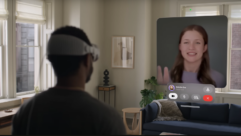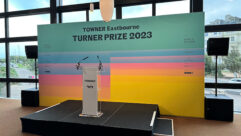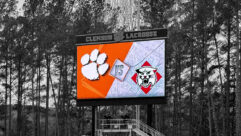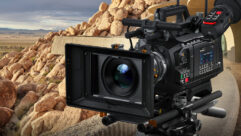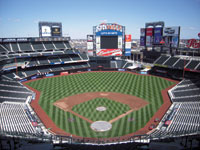

Field Work
Sep 2, 2009 12:00 PM,
By Trevor Boyer
Designing and implementing stadium audio systems for the 2009 MLB season.
On April 13, 2009, the New York Mets hosted the San Diego Padres in its new home, Citi Field. The AV system in the new stadium was designed by Wrightson, Johnson, Haddon & Williams (WJHW) of Dallas and implemented by integration firm TSI Global.
This April, a unique event in baseball history took place: two professional teams in the same city moved into new stadiums in the same season. In the Bronx, the New York Yankees moved into a new home across the street from the then-still-standing old Yankee Stadium (at press time, demolition is under way and should be complete by June 2010), and the New York Mets also moved across the street from its previous home (Shea Stadium) in Queens.
On April 13, the Mets hosted the San Diego Padres for the official Opening Day of Citi Field. The next morning, after the successful debut of a new digital audiovisual system, employees of integration firm TSI Global were working out some of the last remaining kinks in the stadium’s signal distribution. Embedded audio from one of the broadcast truck docks was coming into the stadium embedded on the wrong channel. “I know we had that working last week,” said Dave Potts, senior field engineer with TSI. At that point just after the stadium’s official opening, Potts said that his team was almost done implementing the AV system and was for the most part simply awaiting final punch-out from Wrightson, Johnson, Haddon & Williams (WJHW) of Dallas, the designer of the system.
The design of the new Citi Field has some roots in St. Louis. TSI Global, which is based in nearby St. Charles, Mo., had integrated the AV system at the then-new Busch Stadium, which opened in 2006 as the home to the St. Louis Cardinals. Like that of Citi Field, Busch’s AV system was designed by WJHW. Both Busch Stadium and Citi Field were designed by architects HOK Sport Venue Event (now known as Populous) and built by general contractor Hunt Construction Group.
Citi Field’s AV system also shares many elements with that of similarly sized Busch Stadium. Both systems are powered by Crown CTs series amplifiers—more than 210 units for Busch and 242 in Citi’s case. BSS Soundweb London BLU systems process the signals for both systems via an Ethernet-based CobraNet architecture. But advances in technology since 2006 allowed WJHW and TSI to grant more power to the Citi Field’s system operator. Specifically, Harman’s HiQnet System Architect software gives the operator unprecedented control over and monitoring of individual system components throughout the stadium’s bowl, press boxes, luxury suites, restaurants, stores, and other areas.
The platform also represents an advance because it can stand alone. System Architect controls both the amplifiers and the DSP system (the 40-plus London BLU boxes around the stadium), which means that operators do not need to switch computers (typically done via KVM switching) to move from monitoring power amplifiers to adjusting DSP. Josh Beaudoin, who worked as a consultant at WJHW during the design phase of the process, designed the audio portion of Citi Field’s system. “The ability to now both monitor the BSS and the Crown from a single interface provides much better system monitoring capabilities because we can monitor heat in all the amplifier rooms from the remote System Architect interface,” he says. “We can remotely monitor any audio that’s happening in the box, and then lastly, we can schedule things in the stadium from System Architect.” (Beaudoin is now director of marketing, installed sound with Harman/BSS.)
The BSS London system sped up the commissioning process, according to Potts. “We were able to group speakers in such a way that Mark [Schultz, special projects engineer with TSI,] can actually bring up just those speakers within the BSS processor,” he says. “And for each individual array or combination of arrays, he was able to have EQ, delay, high-pass, in some cases low-pass, compressor/limiter level, meters, mutes, polarity—anything you needed. All through BSS.”
Field Work
Sep 2, 2009 12:00 PM,
By Trevor Boyer
Designing and implementing stadium audio systems for the 2009 MLB season.

A digital distributed system handles Citi Field’s audio, with a loudspeaker hanging every 30ft. to 40ft. around the top of the seating bowl. EAW AX 396, 364, and 344, and EAW MK series loudspeakers cover the bulk of the seating.
Potts cites the audio from the video replay as an example of a difference between the functions of the systems at Busch Stadium and Citi Field. “The difference in this system is that the audio operator controls absolutely every audio that’s heard in the system here,” he says. “At Busch, they have a sub-mixer from the video-replay system that’s fed to the audio system.” (One measure of the degree of the AV systems’ complication might be the miles of cable that snake around both stadiums. At Citi Field, Potts estimates that there’s 200 miles of cable, much of which sits in neat, dense rows in two trays that hang from the ceiling of the service-level underbelly of the stadium.)
For the New York Mets organization, the comparison is not Busch Stadium but Shea Stadium, which was quickly demolished as Citi was being built across the street (relatively quickly, by New York standards, that is). Shea had an analog audio system based on a center cluster of loudspeakers. At Citi, it’s a digital distributed system, with a loudspeaker hanging every 30ft. to 40ft. around the top of its seating bowl. AX series (396, 364, and 344) and MK series loudspeakers from EAW cover the bulk of the seating at Citi. The long-throw EAW AX loudspeakers are custom units designed by the manufacturer and WJHW specifically for Citi Field.

In some areas, especially in seats under a roof, the low frequencies produced by standard long-throw AX loudspeakers would be excessive. “When you’re under deck here, sound has a tendency to billow,” Potts says. “It builds up, and that low frequency makes things unintelligible.”
According to Beaudoin, it’s a simple result of the inverse square law that dictates how volume dissipates over distance. Ideally, you want a 3:1 to 4:1 ratio between the farthest reach of the loudspeaker throw and your closest listener. “Because of the architectural design of that stadium, the ratios were bad, and we were forced to put the loudspeakers on club level,” he says. “If the throw to your furthest seat is 100ft. and the measured SPL at that seat is 100dB, then somebody sitting right underneath that same loudspeaker is hearing about 120dB.”
To alleviate that problem, EAW and WJHW designed “canceling” woofers for the bottoms of the cabinets, which sit at a 90-degree angle to the cabinet front. Each cabinet has dual 10in. woofers, and technically they don’t cancel frequencies so much as reduce them. “The concept is to create a companion source of same signal but different phase so as to provide cancellation of the main signal in areas where the main is excessive in level,” says Kenton Forsythe, EAW co-founder and VP for strategic engineering. “I say ‘phase’ as it is not merely inverted polarity. The adjustment is done with time and level so as to maximize the reduction where it is needed, with minimal reduction of the forward radiation.”
Beaudoin estimates that in Citi Field, the “canceling” woofers effectively reduced the low frequencies by 6dB to 8dB. Higher frequencies (above 500Hz) were not as much of a problem, because they respond much better to the directionality of the loudspeakers.
Field Work
Sep 2, 2009 12:00 PM,
By Trevor Boyer
Designing and implementing stadium audio systems for the 2009 MLB season.

More than 90 JBL Contractor Series Control 29s cover the stadium’s private suites and certain fill areas near home plate.
The seating is just one section of the stadium; for the purposes of the AV system, there’s also the back of house (concession, clubs, bathrooms) and broadcast (camera positions, press interview facilities, etc.). More than 90 JBL Contractor Series Control 29s cover the stadium’s private suites and certain fill areas near home plate and in the “home run porch” in left field; and Tannoy CMS6 and Di6 DCT loudspeakers are installed in bathrooms and concession areas.
The bulk of the power for Citi Field’s loud¬speakers is supplied by Crown CTs 3000 amplifiers, which serve mainly the front-firing horns of the EAW AX series units. CTs 2000 amplifiers power the rear-firing components of those custom boxes. From the audio source—a Yamaha M7CL 48-channel digital mixer drives the system from the control room over home plate—to the amplifier closets, audio travels as CobraNet over Cat-5; from the closets out to the loudspeakers, it’s over copper wire.
At the same time as the company was designing Citi Field’s audio system, WJHW was also at work developing the new Yankee Stadium’s system. For both stadiums, a new hybrid BSS signal-distribution scheme was used for the respective DSP systems that made them much more fault-tolerant than was previously possible. Beaudoin describes a “distributed” DSP design. “At both those stadiums, we used smaller DSP processors that were linked together via both CobraNet and the BSS digital audio bus,” he says.
CobraNet runs on Cat-5 through network switches; it originates at the control room over home plate. That signal runs to each of three amplifier rooms above first base, third base, and center field. There’s also an analog audio backup running to these rooms in case CobraNet fails. From these rooms, a digital audio bus links the BSS London BLU DSP boxes to each other in two directions via Cat-5. The boxes essentially form a ring. “That’s how you get that redundancy,” Beaudoin says. If one box fails, the DSP signal switches directions and there’s no break in audio.

Video for Citi Field is produced in full 1080 HD and displayed on more than 800 video monitors.
Beyond audio
WJHW designed and TSI Global integrated more than just the audio system for the New York Mets’ new stadium in Queens, N.Y. For one thing, TSI Global designed and assembled all the Middle Atlantic equipment racks for Citi Field’s AV systems in its Missouri facility.
The stadium also has more than 800 video monitors throughout the facility in concourses, restaurants, club spaces, and an adjoining 200,000-square-foot event space. Provided by Sharp, these Aquos LCD HDTVs display both the live game (via four inhouse channels) and dozens of local and satellite channels. Inhouse channels are produced in full 1080 HD.
TSI was not responsible for the hanging of the actual Sharp sets, but it was tasked with supplying a signal to each of the hundreds of monitor locations, as well as infrastructure to facilitate mounting, electricity, and a cable drop. Passing these HD signals around such a large building was a challenge, according to Dave Potts, senior field engineer with TSI, because all the channels had to travel down a single fiber out to relay locations. “We’re not just distributing an RF signal,” Potts says. “We’re distributing the entire complement of DirecTV down that pipe also.” From one rack room, the signals are distributed to a series of equipment closets, for signal relay out to the displays. Balancing the signals traveling on that single fiber was a challenge for the integration team.
Inhouse channels, such as the stadium’s video replay, are generated as full 1080-line HD signals and encoded to MPEG using four Adtec Digital MediaHub-HD Pro encoders. The system then modulates the MPEG stream to an ASI stream. That stream enters a modulator, which converts it over to a QAM signal for over-the-air distribution.
TSI also integrated the cabling and connectivity for all the stadium’s broadcast locations, such as camera positions, interview locations, and broadcast truck docks. (This broadcast “connectivity” required the building of several dedicated racks.)
Field Work
Sep 2, 2009 12:00 PM,
By Trevor Boyer
Designing and implementing stadium audio systems for the 2009 MLB season.

Crown CTs 3000 amplifiers power the front-firing horns of the EAW AX series loudspeakers at Citi Field. CTs 2000 amplifiers serve the rear-firing components of the custom “canceling” woofers in the stadium, as well as systems at Yankee Stadium.
Crosstown similarities
A design firm and a fault-tolerant DSP design aren’t the only things that the new Yankee Stadium’s seating bowl sound-reinforcement system shares with that of Citi Field. Both systems rely on more than 200 Crown CTs series amplifiers to power their loudspeakers, at least 40 BSS London BLU boxes for signal processing, and System Architect software for the initial tuning and the day-to-day control of the respective systems. One major difference: The Yankee Stadium seating bowl design called for more than 600 JBL AM4212, PD5322, and Control 30 loudspeakers.
Skip Warrington of AVI-SPL’s large projects group in Columbia, Md., served as the senior project manager for the Yankee Stadium project, for which AVI-SPL implemented both sound reinforcement and control for the stadium’s seating and back-of-house (restaurants, press rooms, etc.) systems and the miles of audio and video cabling throughout the stadium. Warrington started working on the New York Yankees project in September 2007, but an 18-month lead time is nothing new for a large stadium project.
As with TSI and Citi Field, it was AVI-SPL’s job to integrate WJHW’s design for the Yankee Stadium audio system. The lead time made for an easier installation, he says. “One thing WJHW does that we really, really like is while they’re still putting steel up in the air, we’ll hang a set of speakers along two or three column lines looking for typical column-line profiles,” Warrington says. “They’ll literally tune these things while they’re stuck up on a pole. And what that gives us is all the parameters we need—the initial levels that we want, the aiming angles. So when we’re ready to turn this thing on, I don’t have to have a crew running around with a scaffold and ladders trying to re-aim speakers. They’re done.” Even with more than 600 loudspeakers in the seating bowl, the installation left no significant gaps in the coverage that needed to be addressed.
That cut down on the manpower that AVI-SPL needed to supply. Warrington estimates he had only three AVI-SPL employees with him in New York during the busiest stretch, from October 2008 through to Opening Day 2009. (The local union electricians numbered about 25 for audio and satellite master antenna television [SMATV] and 40 for broadcast, according to Warrington.) With a skeleton crew of actual AVI-SPL staff, Warrington says the company works more efficiently. “We’re an engineering company, really,” he says.
While engineers were overseeing the pulling of cable, Stephanie Bryl, lead onsite engineer with AVI-SPL, was performing her first programming job within Harman’s System Architect software. It was Warrington’s job to drive the interface she created for the user, the system operator. “She did a good job,” he says. “The two engineers I had on this project were just excellent engineers.” System Architect was also a key component of the tuning and commissioning process; engineers used the software to set parameters for the DSP and the amplifiers.
Warrington, who estimates he has spent 20 of the last 30 years on the road working on large construction projects, says he stayed in New York into June. During the early part of the season, he addressed issues such as the odd bad connector and customer confusion with touchpanel controls going into autoshutdown.
Field Work
Sep 2, 2009 12:00 PM,
By Trevor Boyer
Designing and implementing stadium audio systems for the 2009 MLB season.

At Citi Field, a Yamaha M7CL 48-channel digital mixer drives the audio system from the control room over home plate. From the mixer to the amplifier closets, audio travels as CobraNet over Cat-5; from the closets to the loudspeakers, it’s over copper wire. A Yamaha M7CL is also used at Oriole Park at Camden Yards.
Meanwhile, down the coast
This year, AVI-SPL was also busy closer to its Columbia, Md., office. The Maryland Stadium Authority wasn’t building a new stadium for the Orioles; rather, it was having the existing AV system completely overhauled at Oriole Park at Camden Yards. That meant pulling out all existing audio components except for the copper wire. The stadium authority hired AVI-SPL to integrate a new seating bowl sound-reinforcement design from SIA Acoustics in New York, which also served as a consultant on the project.
Related Links

The Buzz: Installation Spotlight: Crisler Arena, Ann Arbor, Mich.
Time had come for a change—the 40-plus-year-old PA system at the Crisler Arena…

Security Watch: Securing Sports Arenas
In March 2005, the Department of Homeland Security (DHS) released a document titled National Planning Scenarios, which offered estimates of probable death…

The Buzz: Installation Spotlight: Izod Center, East Rutherford, N.J.
With the departure of the New Jersey Devils hockey team from the Izod Center in East Rutherford, N.J., for a new home at the Prudential Center in Newark,…
This project’s timeframe was a lot slimmer than that of Yankee Stadium. “We were authorized to proceed in late October 2008, and we came online when they threw the first pitch in the beginning of April,” says Don Alberg, the AVI-SPL design engineer and project manager who was responsible for the engineering and drafting of the audio systems as well as the field coordination of the installation. He’d also worked on the engineering and integration of Camden Yards’ original system when the stadium was built in 1992. “We hit the ground running on this one,” he says of the 2009 overhaul. “We were working long hours to get it done on time, but that’s what AVI-SPL does. It’s like a performance.”
Alberg estimates he had 14 people working on the job in engineering and onsite. As with Yankee Stadium, AVI-SPL subcontracted the hanging of loudspeakers and pulling of wires to an electrical contractor. AVI-SPL crews completed the terminations. For this project, SIA Acoustics’ design specified EAW loudspeakers, mainly AX364 long-throw models and MK2364 nearfield cabinets. For Camden Yards, EAW also custom-designed the FX100, a weatherized version of its JF100 two-way loudspeaker.
As for amplifiers and DSP modules, it’s once again the combination of Crown CTs (CTs 3000 and CTs 2000 with PIP-Lite modules) and BSS London BLU (320, 160, and 120 models). The PIP-Lite amplifier modules enable digital control of amplifier gains, mute, power and load-monitoring status. AVI-SPL set DSP parameters using BSS’s London Architect software. “Then we migrated control functions over to System Architect for the user interface,” Alberg says. System Architect has the ability to control both BSS and Crown parameters. After copying parameters from London Architect to System Architect, the former did not need to be kept running. However, Alberg taught the operator to use both programs.
Tuning and commissioning at Oriole Park went fairly smoothly, as new loudspeakers replaced the older models almost one-for-one at their existing positions. “There were no dead zones in the existing system, so using that as a model to install the new system, that took all that guesswork out,” Alberg says. “We pretty much knew what we were up against when we walked in the building.”
For its part, the control room underwent an analog-to-digital distribution transition, necessitating a complete rebuild. Along with installing a Yamaha M7CL 48-channel digital console and training the operator how to use it, AVI-SPL also rebuilt the control room racks and installed new patchbays. At the same time as the audio system was being switched from analog to digital, Camden Yards was receiving an upgrade to its video-production infrastructure.


